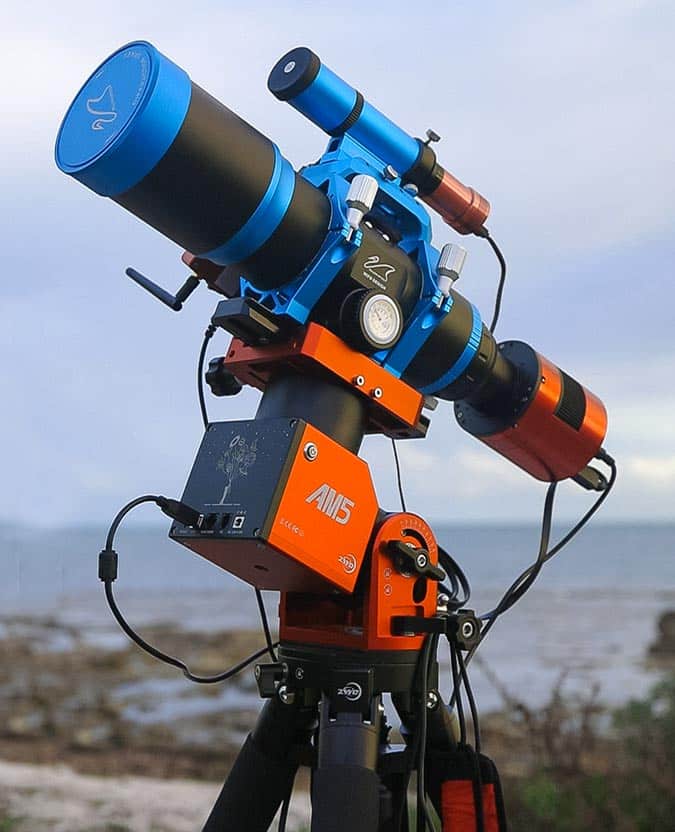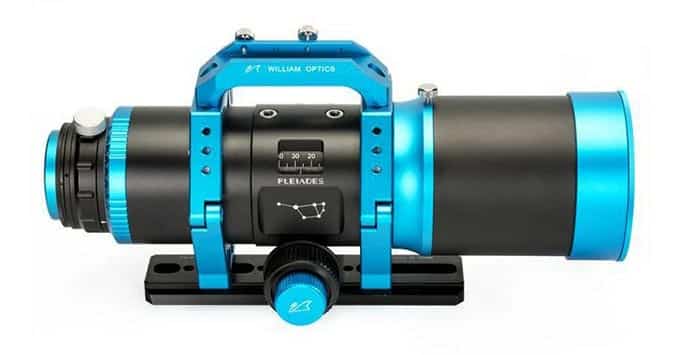William Optics Pleiades 68 Review
In late 2023, William Optics announced the Pleiades 68 Astrograph. A compact, 7-element astrograph design featuring Super 3 ED lenses and FPL-53 glass.
The biggest selling features of the William Optics Pleiades 68 Astrograph are its fast focal ratio of f/3.8 and innovative WIFD focuser design.
I had the pleasure of testing one of the first Pleiades 68 models at the Winter Star Party in early 2024. I’ll share my image results and impressions of this compact refractor telescope in this article.
The Pleiades 68 is currently listed for a price of $1,998 at Agena Astro.
For those looking for a little more aperture, this telescope also comes in a 111mm version. However, the William Optics Pleiades 111 does not share the same light-gathering ability (the 111 is F/4.8) as the smaller 68mm version.
The William Optics Pleiades 68 offers an impressive balance between portability, optical performance, and light-gathering power. At F/3.8, it is the fastest refractor telescope I have ever used.
If your interests lie in wide-field deep-sky astrophotography, you’ll be hard-pressed to find a compatible telescope that is full-frame compatible at this price. Read on for more best-use scenarios and image data examples.
William Optics Pleiades 68 Review
I captured one of my favorite deep-sky images of all time using the Pleiades 68. I utilized the massive field of view of the telescope by using a full-frame one-shot-color astronomy camera.
The following image was captured over 2 nights from a Bortle Scale class 3 sky at the 40th annual Winter Star Party. For those familiar with the Witch Head Nebula, you’ll know just how large this area of the sky is.
The Witch Head Nebula. Pleiades 68 + ZWO ASI2400MC Pro. (3 Hours Total)
This telescope is an excellent choice for anyone who owns a full-frame astronomy camera, as the listed 48mm image circle was full-frame compatible as advertised.
The image data looked spectacular from edge-edge-edge, with tight, round stars across the frame. This is an impressive feat considering the extremely fast f-ratio of the telescope.
Here is a look at a single sub-frame before I used my image stacking software (I used the WBPP script in PixInsight this time) to compile the final image. The Abberation Inspector tool in PixInsight is ruthless in the evaluation of field flatness and coma.
A single 180-second sub-frame captured using the Pleiades 68 with a full-frame CMOS camera. (Abberation Inspector).
Don’t be alarmed if the edges of the frame in the example above don’t look absolutely perfect. Keep it mind that this was taken with the enormous full-frame image sensor on the ZWO ASI2400MC Pro.
I believe the star quality could be improved further with a slight adjustment to the backspacing and/or a tilt adjustment. I’ll discuss how critical the backspacing on the Pleiades 68 must be a little later on.
Pleiades 68 Specifications
This telescope excels at wide-field deep-sky astrophotography of large nebulae. The native focal length is just a little more than the RedCat 51 (which was 250mm), which is one of the widest apochromatic refractors on the market.
The Pleiades takes these specifications one step further, by slightly increasing the magnification, and dramatically boosting its light-gathering ability.
- Focal Length: 260mm
- Diameter: 68mm
- Aperture: f/3.8
- Image circle: 48mm FF
- Flattener: No Flattener Required
- Focuser: Internal Focus Design
- Lens Material: FPL-53
- Tube Length: 346mm
- Extended Tube Length: 410mm
- Total Weight: 8.38lbs / 3.8kg
I discovered first-hand that the Pleiades 68 is the ultimate travel astrophotography telescope. This telescope was compact and lightweight enough to fit in my carry-on luggage on an airplane.
When traveling, I refuse to check my astrophotography telescope on the plane. If it doesn’t fit in my carry-on luggage (or personal item backpack), it does not come with me.
The Pleiades 68 is one of only a handful of astrophotography telescopes that are compact enough for travel. A comparable option in this category is the equally impressive RedCat 61, which trades a little light-gathering power for magnification.
Travel-Friendly Astrophotography Telescopes:
- William Optics RedCat 51: 250mm at F/4.9
- William Optics RedCat 61: 300mm at F/4.9
- William Optics Pleiades 68: 260mm at F/3.8
Gum 15 in the constellation Vela. William Optics Pleiades 68 + ZWO ASI2400MC Pro.
The Pleiades is extremely stocky. It weighs much more than you think it would (almost 9 pounds) considering its small profile. At this weight, it is best used with an equatorial telescope mount rather than a star tracker.
If portability is a concern, I recommend using the extremely capable ZWO AM5 strain wave drive mount, or the even smaller ZWO AM3. It feels like the Pleiades 68 was built for these mounts.
WIFD Focuser
The WIFD (William Optics Internal Focus Design) is a dream. I much prefer this style of focuser to the helical focuser found on the original RedCat 51 and RedCat 71 astrographs.
Focusing the Pleiades 68 using the included, built-in Bahtinov mask is an absolute pleasure. The fine-focusing knob is also great when utilizing the focus feature of the ZWO ASIAIR via a FWHM reading on the smartphone app.
It helps balance the overall weight of your imaging system closer to the center (which makes declination balance much easier), but it does add weight to the system as well.
While added weight is not always ideal, in my use case, I was thrilled to have a beefier payload while imaging under 25 mph winds on the beach!
My Astrophotography Setup for the Example Images:
- Telescope: William Optics Pleiades 68
- Mount: ZWO AM5
- Camera: ZWO ASI2400MC
- Guide Scope: William Optics 32mm
- Guide Camera: ZWO ASI120MM Mini
If you plan to install an autofocuser on this telescope, reference the handy Pleiades 68 instruction manual. It includes detailed instructions and pictures for installing an electronic autofocuser such as the popular ZWO EAF.
The process involves removing the focuser knob on the telescope with a 2mm Allen key and fastening the bracket on the EAF to the bottom of the telescope.
Tilt Adapter and Camera Angle Rotator
The Pleiades 68 features a handy camera angle rotator. This is a manual process that will need to take place before you run your imaging plan.
I like to use the Sky Atlas feature in the ASIAIR to see my current object framing, and then make adjustments to the camera angle from there. The framing window in the SKy Atlas will update to your latest angle after taking a preview image.
The tilt adapter can be found inside of the camera angle rotator at the rear of the telescope. You need to remove the camera angle rotator knob, and twist the blue cover off (the one with the angle markings on it).
To adjust the tilt, you need to use a small Allen key to ‘push’ or ‘pull’ the small set screws. Be careful during this process, a small adjustment can make a big difference.
The Tilt Adapter is found underneath the camera angle rotator cover.
Backspacing
The earliest Pleiades 68 units were quite particular on backspacing, including the unit I had for testing. As usual, the situation was discussed at length on Cloudy Nights.
The recommended backspacing for the Pleiades 68 is 55mm, but it ended up being closer to 57.5mm in my experience. Since then, William Optics has begun making adapters which will be sent to all initial customers to resolve this issue.
The adapter is approximately 3mm longer than the original, which will allow you to use the standard 55mm backspacing with the Pleiades 68. Again, this is only needed for the first batch of Pleiades 68 telescopes that went out.
It is important you reach and maintain the exact level of back focus for the Pleiades 68 to perform optimally. Once you have, you can enjoy a flat image field with round stars edge-to-edge.
The new production units will use the standard 55mm backspacing requirements. (Mine required 57.5mm).
Attaching Your Camera and Filters
The Pleiades 68 includes 2 camera mounting adapters (48mm and 54mm). This is where you will thread your dedicated astronomy camera or DSLR to the telescope with the appropriate (55mm, moving forward) backspacing.
For my testing, I did not use a filter to show the true performance of this telescope’s optics and color correction. While this is the best-case scenario for the Pleiades 68, astrophotographers in the city will no doubt be using some sort of light pollution filter with this ‘scope.
The Pleiades 68 does not feature an internal M48 filter thread the way many other refractor telescopes do. This is due to its proximity to the second lens group at the rear end of the telescope, to avoid interference with the lenses inside of the telescope.
For the best results, consider attaching an electronic filter wheel (or filter slider drawer) in front of your dedicated astronomy camera. If you are using a DSLR or Mirrorless camera, a clip-in filter that snaps inside of the camera body is best.
What’s Included in the Box?
- Pleiades 68 APO telescope
- William Optics Signature Bahtinov Cap
- M48/M54 camera adapter included
- Dual mounting plate
- Mounting rings with handlebar
- Soft ‘constellation’ carry case
- Allen key set
As usual, the package and presentation of the Pleiades 68 is top-notch. The innovative branding, color-matched accessories, and stitched Pleiades asterism bag make you feel warm and fuzzy about your purchase.
There is no need for an additional optical element (such as a field flattened or reducer) with this telescope, meaning you will be off the races as soon as it arrives. Just make sure you get that backspacing right.
Final Thoughts
I have had the pleasure of testing many William Optics refractor telescopes over the years, and they all have one thing in common: value. William produces telescopes for astrophotographers that are meant to be used, not sit on a shelf collecting dust.
The thoughtful touches that go into the product, from both a technical and aesthetic standpoint, do not go unnoticed. Even if you don’t care about having a stitched color-matched carry case for the Pleiades, you’ll appreciate the F/3.8 optics and full-frame compatibility.
While the critical back spacing this telescope requires may cause some temporary headaches, it is a one-time deal. I was able to utilize the thin paper-like spacers included with the telescope to reach 57.5mm of backspacing, which is pretty close to perfect.
The newer models are said to accommodate the standard 55mm back spacing requirement perfectly, so I will have to report back when this has been completed. In the meantime, I expect to see many more incredible images taken with the Pleiades 68 shared online by satisfied customers.
The William Optics Pleiades 68 is available at Agena Astro.
Keep in mind that 260mm is an extremely wide focal length in the telescope world. This means that photographing planets is not this telescope’s strong suit. Stick to large nebulae regions and star clusters when using the Pleiades 68.
Pros:
- Super fast focal ratio (double the light gathering speed of an F/5.6 telescope)
- All-in-one package without the need for additional lenses such as a corrector/field flattener
- Precision focuser with improved balance and stability
- Includes all mounting hardware and accessories including guide scope mount and built-in focus mask
Cons:
- Wide-field of view is not suitable for planets or small galaxies
- Filter placement may be difficult due to the optical design
- Backspacing is critically important for optimal performance
Helpful Resources:
- My Full-Size Example Image on AstroBin
- Official Product Page (WilliamOptics.com)
- Pleiades 68 Instruction Manual (PDF)










